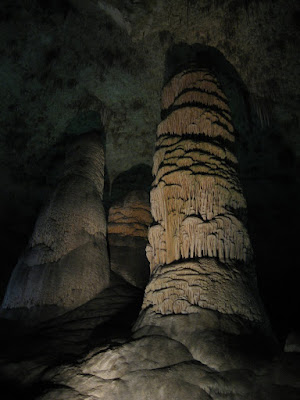
Carlsbad from the outside
We arrived at Carlsbad Caverns National Park in Whites City, NM and discovered that we had unwittingly traded away the opportunity to walk from the mouth of the caverns all the way to the main chamber (745 vertical feet and approximately 1.5 miles) for our leisurely drive along the Rio Grande. We were totally okay with that, but Gary (see Austin post) had told us that there is lots to be seen along this winding tunnel stroll, so for anyone planning to visit you should be sure to arrive before 2 pm. Well, that comes with the disclaimer that you should take the natural entrance only if you do not suffer from chiroptophobia (fear of bats).
Our somewhat lame arrival (we took the elevator) did not detract from the awesomeness of the caverns. I mean that literally. It took us almost 2 hours to complete a self-guided loop of the parts that are open to the public and there are still chambers and passages being discovered. The imaginatively titled Big Room is the size of 6 football fields and over 250 feet high in places. The aptly named Hall of Giants contains the cavern's largest formations, including the awe-inspiring Rock of Ages. Pits up to 140 feet deep, some filled with jagged stalagmites, can be found to the sides of the walking path. Exploring the caverns without the help of installed lighting (which now includes over 1000 bulbs requiring over 6 miles of concealed wiring) must have been a little nerve-wracking, especially for first guy to use this makeshift ladder during National Geographic's visit in 1924:

Oh hell no.
Here is an entirely cribbed description of the caverns' origins:
The story of the creation of Carlsbad Cavern begins 250 million years ago with the creation of a 400 mile long reef in an inland sea that covered this region. This horseshoe shaped reef formed from the remains of sponges, algae and seashells and from calcite that precipitated directly from the water. Cracks developed in the reef as it grew seaward. Eventually the sea evaporated and the reef was buried under deposits of salts and gypsum.
Then, a few million years ago, uplift and erosion of the area began to uncover the buried rock reef. Rainwater, made slightly acidic from the air and soil, seeped down into the cracks in the reef, slowly dissolving the limestone and beginning the process that would form large underground chambers. At the same time, hydrogen sulfide gas was migrating upward from vast oil and gas deposits beneath the ancient reef. This gas dissolved in the percolating ground water to form sulfuric acid. The added power of this corrosive substance explains the size of the passageways. The exposed reef became part of the Guadalupe Mountains and the underground chambers became the wonder of Carlsbad Cavern.
Predictably, our trusty little Canon PowerShot could not adequately catalogue the sheer size and intricacy of the limestone formations within the caverns. It turns out that Carlsbad Caverns is something best appreciated in person. Here are a few shots that came out okay, but seriously it is so much cooler than this:
"Curtain" speleothems

"Column" speleothems

"Soda straw" stalactites and a mix of stalagmites

"Popcorn" stalagmites

This is a picture taken straight up. It's a part of the cavern ceiling reminiscent of the scene in Indiana Jones and the Temple of Doom when the spikes descend on Indy and Short Round.
When our eyes finally adjusted to the late afternoon sun following our return to the surface, we headed north to the town of Carlsbad, NM for dinner and camping. Our plans were to get up before dawn and haul over to White Sands National Monument for a few hours before continuing on to Silver City, NM. If you find yourself driving through New Mexico, make a point of stopping to explore Carlsbad Caverns (they even have a temperature controlled kennel behind the gift shop so your dog will be safe from the heat of the parking lot!). Stay tuned for adventures in White Sands...
"COVER YOUR HEART DR. JONES!!!!"
ReplyDelete